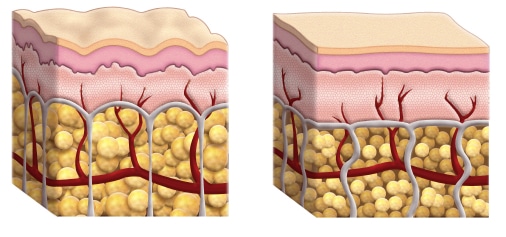
What Causes Cellulite?
Cellulite is really just fat poking through the skin’s underlying support structure. The upper level of the skin is called the epidermis. Beneath this outer layer of the skin lies the dermis, an area that’s rich in blood vessels and collagen, the protein that gives skin its support. Dig a little deeper and you’ll find the subcutaneous fat layer where fat cells reside. Here, there are fibrous cords that anchor fat cells to the underlying muscle. As fat cells expand, they push against these cords. This leads to the dimpling and lumpy thighs we know of as cellulite.
The reason men are less likely to get cellulite than women is because of the way these fibrous bands are organized. In men, the bands are smooth and uninterrupted, and there are less “points” where the underlying fat can poke through. In women, the fibrous cords aren’t as well reinforced, and there are regions where the fat can herniate into the dermis, creating that lumpy, orange peel look.
Does Exercise Help Cellulite?
According to Dr. Lisa Donofrio, M.D., assistant professor of dermatology at Yale University, exercise can improve the appearance of cellulite, but aerobic exercise alone won’t do it. To get the benefits, she emphasizes that you need to do resistance workouts to build muscle – not just aerobics. Adding additional muscle helps the skin lay more smoothly over the muscle, which reduces dimpling. At the same time, exercise reduces body fat, which means there’s less subcutaneous fat to poke through.
Keep in mind that exercise isn’t a “cure” for cellulite, but it may improve its appearance. If you develop some degree of musculature in your butt and thighs, any existing cellulite is going to be less noticeable. In addition, the less body fat you carry in those areas, the less visible cellulite there will be, so weight loss helps as well.
Unfortunately, too many people are looking for quick solutions to cellulite. They’d rather rub cream on their thighs than do squats and lunges. The simple reality is that no cream or lotion currently available significantly reduces cellulite, although there are treatments that hold some promise. These include systems that use infrared light, radiofrequency waves and negative tissue massage. Unfortunately, these are expensive therapies with results that aren’t necessarily permanent.
Cellulite and Exercise: The Bottom Line?
Exercise that includes strength-training combined with weight loss is currently the best option for keeping cellulite at bay. Before investing in creams and lotions that claim to melt away cellulite, get out the weights, and start doing something good for your butt and thighs. Don’t waste your money on quick fixes for cellulite.
References:
Shape Magazine. “Workout Routine to Get Rid of Cellulite”
Mayo Clinic. “Cellulite”

